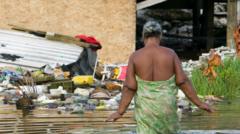The frequency and intensity of extreme rainfall are escalating globally, particularly in places like Texas, where historically severe weather events have become amplified due to human-caused climate change. This alarming trend, primarily linked to fossil fuel emissions, has resulted in conditions that foster severe downpours.
Extreme Downpours Associated with Climate Change: Texas Flooding Events Intensify

Extreme Downpours Associated with Climate Change: Texas Flooding Events Intensify
As temperatures rise due to climate change, extraordinary rainfall events are becoming increasingly common, leading to catastrophic flooding, particularly in Texas.
Warm air has the capacity to hold significantly more moisture than cooler air, and as global temperatures rise, this effect leads to storms generating heavier rainfall. The consequences of such deluges, when combined with insufficient infrastructure and inadequate warning systems, can be disastrous. In Texas, known for its diverse climate extremes—ranging from scorching heat to frigid cold and torrents of rain to severe drought—these factors culminated in a recent tragedy.
The Hill Country region, often referred to as “flash flood alley,” is particularly vulnerable to sudden flooding events. The geographical conditions are conducive to severe storms when humid air from the Gulf of Mexico and the tropical Pacific collides with cooler air descending from the Great Plains. The region's hilly landscape exacerbates the situation by quickly channeling rainfall into river valleys, overwhelming the waterways.
In a recent incident, an astonishing amount of rain fell in just six hours, with a likelihood of occurrence of less than 0.1% in any given year, as reported by Russ Schumacher, an atmospheric science expert from Colorado State University. The Guadalupe River exemplified this severe flooding event, experiencing an intense spike in water levels from three feet to 34 feet in about 90 minutes, with water flow surging from 95 cubic feet per second to 166,000 cubic feet per second.
As climate change continues to fuel these extreme rainfall events, it raises critical questions about preparedness and infrastructure resilience in heavily impacted areas like Texas.
The Hill Country region, often referred to as “flash flood alley,” is particularly vulnerable to sudden flooding events. The geographical conditions are conducive to severe storms when humid air from the Gulf of Mexico and the tropical Pacific collides with cooler air descending from the Great Plains. The region's hilly landscape exacerbates the situation by quickly channeling rainfall into river valleys, overwhelming the waterways.
In a recent incident, an astonishing amount of rain fell in just six hours, with a likelihood of occurrence of less than 0.1% in any given year, as reported by Russ Schumacher, an atmospheric science expert from Colorado State University. The Guadalupe River exemplified this severe flooding event, experiencing an intense spike in water levels from three feet to 34 feet in about 90 minutes, with water flow surging from 95 cubic feet per second to 166,000 cubic feet per second.
As climate change continues to fuel these extreme rainfall events, it raises critical questions about preparedness and infrastructure resilience in heavily impacted areas like Texas.




















